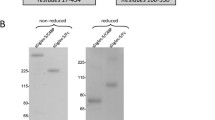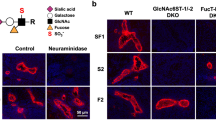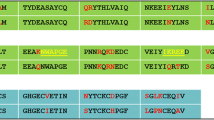Abstract
Purpose. E-selectin is a cell adhesion molecule that is specifically expressed in the inflammatory vascular endothelium in response to cytokines such as IL-1β and TNF-α, and interacts with specific ligands containing sialyl Lewis X (Neu5Acα2-3Galβl-4(Fucαl-3)GlcNAc-, SLex). In order to investigate the ability of E-selectin ligands to target the inflammatory site, the tissue distribution of carboxymethylpullulan (CMPul) modified with SLex was studied.
Methods. CMPul conjugates with various saccharides containing SLex and monovalent SLex were intravenously administered to mice with ear edema induced by arachidonic acid, and their distributions to the inflamed ear and other tissues were studied. To determine the microdistributions of these compounds, the inflamed ear was subjected to microautoradiography.
Results. After intravenous administration AUC0-24h of SLex-CMPul, which binds to E-selectin, in the inflamed ear was about 300-fold and 2.5-fold higher than that of monovalent SLex and CMPul conjugated with other saccharides, which can not serve as ligands for E-selectin. Microautoradiography also revealed SLex-CMPul accumulated at the microvessels in the inflammatory lesions.
Conclusions. SLex-CMPul was found to have the potential to target drugs to the inflammatory lesion.
Similar content being viewed by others
REFERENCES
N. Murahashi and A. Sasaki. In vivo behavior of liposomes modified with a novel galactosyllipid derivative. Biol. Pharm. Bull. 19:418–423 (1996).
R. P. McEver. Leukocyte-endothelial cell interactions. Curr. Opin. Cell Biol. 4:840–849 (1992).
M. Larkin, T. J. Ahern, M. S. Stoll, M. Shaffer, D. Sako, J. O'Brien, C-H. Yuen, A. M. Lawson, R. A. Childs, K. M. Barone, P. R. Langer-Safer, A. Hasegawa, M. Kiso, G. R. Larsen, and T. Feizi. Spectrum of sialylated and nonsialylated fuco-oligosaccharides bound by the endothelial-leukocyte adhesion molecule E-selectin. J. Biol. Chem. 267:13661–13668 (1992).
H. Nogusa, T. Yano, S. Okuno, H. Hamana, and K. Inoue. Synthesis of carboxymethylpullulan-peptide-doxorubicin conjugates and their properties. Chem. Pharm. Bull. 43:1931–1936 (1995).
Y. Takakura and M. Hashida. Macromolecule carrier systems for targeted drug delivery: pharmacokinetic considerations on biodistribution. Pharm. Res. 13:820–831 (1996).
M. Sakagami, K. Horie, K. Nakamoto, T. Kawaguchi, and H. Hamana. Sialyl Lewis X-polysaccharide conjugates: targeting inflammatory lesions. Bioorg. Med. Chem. Lett. 8:2783–2786 (1998).
M. N. Gibbons. The determination of methylpentoses. Analyst (London) 80:268–276 (1955).
W. M. Hunter and F. C. Greenwood. Preparation of iodine-131 labelled human growth hormone of high specific activity. Nature (London) 194:495–496 (1962).
G. Walz, A. Aruffo, W. Kolanus, M. Bevilacqua, and B. Seed. Recognition by ELAM-1 of the sialyl-LeX determinant on myeloid and tumor cells. Science 250:1132–1135 (1990).
O. Cecconi, R. M. Nelson, W. G. Roberts, K. Hanasaki, G. Mannori, C. Schultz, T. R. Ulich, A. Aruffo, and M. P. Bevilacqua. Inositol polyanions; noncarbohydrate inhibitors of L-and P-selectin that block inflammation. J. Biol. Chem. 269:15060–15066 (1994).
G. Mannori, P. Crottet, O. Cecconi, K. Hanasaki, A. Aruffo, R. M. Nelson, A. Varki, and M. P. Bevilacqua. Differential colon cancer cell adhesion to E-, P-, and L-selectin: role of mucin-type glycoproteins. Cancer Res. 55:4425–4431 (1995).
J. Yuan. Estimation of variance for AUC in animal studies. J. Pharm. Sci. 82:761–763 (1993).
M. S. Mulligan, J. B. Lowe, R. D. Larsen, J. Paulson, Z-I. Zheng, S. DeFrees, K. Maemura, M. Fukuda, and P. A. Ward. Protective effects of sialylated oligosaccharides in immune complex-induced acute lung injury. J. Exp. Med. 178:623–631 (1993).
L. Svennerholm. Quantitative estimation of sialic acids. Biochim. Biophys. Acta 24:604–611 (1957).
P. Hensley, P. J. McDevitt, I. Brooks, J. A. Field, D. E. McNulty, J. R. Connor, D. E. Griswold, N. V. Kumar, K. D. Kopple, S. A. Carr, B. J. Dalton, and K. Johanson. The soluble form of E-selectin is an asymmetric monomer. J. Biol. Chem. 269:23949–23958 (1994).
R. T. Lee, Y. Ichikawa, T. Kawasaki, K. Drickamer, and Y. C. Lee. Multivalent ligand binding by serum mannose-binding protein. Arch. Biochem. Biophys. 299:129–136 (1992).
R. Snyderman, M. C. Pike, B. L. Blaylock, and P. Weinstein. Effects of neoplasms on inflammation: depression of macrophage accumulation after tumor implantation. J. Immunol. 116:585–589 (1976).
Y. Takakura, T. Fujita, H. Furitsu, M. Nishikawa, H. Sezaki, and M. Hashida. Pharmacokinetics of succinylated proteins and dextran sulfate in mice: implications for hepatic targeting of protein drugs by direct succinylation via scavenger receptors. Int. J. Pharm. 105:19–29 (1994).
M. P. Bevilacqua, R. M. Nelson, G. Mannori, and O. Cecconi. Endothelial-leukocyte adhesion molecules in human disease. Annu. Rev. Med. 45:361–378 (1994).
D. Rohde, W. Schlüter-Wigger, V. Mielke, P. von den Driesch, B. von Gaudecker, and W. Sterry. Infiltration of both T cells and neutrophils in the skin is accompanied by the expression of endothelial leukocyte adhesion molecule-1 (ELAM-1): an immunohistochemical and ultrastructural study. J. Invest. Dermatol. 98:794–799 (1992).
D. H. Boschelli. Inhibitors of leukocyte-endothelial cell adhesion: a new generation of antiinflammatory therapeutics? Drugs Fut. 20:805–816 (1995).
J. K. Welply, S. Z. Abbas, P. Scudder, J. L. Keene, K. Broschat, S. Casnocha, C. Gorka, C. Steininger, S. C. Howard, J. J. Schmuke, M. Graneto, J. M. Rotsaert, I. D. Manger, and G. S. Jacob. Multivalent sialyl-LeX: potent inhibitors of E-selectin-mediated cell adhesion; reagent for staining activated endothelial cells. Glycobiology 4:259–265 (1994).
P. G. Squire, P. Moser, and C. T. O'Konski. The hydrodynamic properties of bovine serum albumin monomer and dimer. Biochemistry 7:4261–4272 (1993).
I. Saiki, C. Koike, A. Obata, H. Fujii, J. Murata, M. Kiso, A. Hasegawa, H. Komazawa, H. Tsukada, I. Azuma, S. Okada, and N. Oku. Functional role of sialyl Lewis X and fibranectin-derived RGDS peptide analogue on tumor-cell arrest in lungs followed by extravasation. Int. J. Cancer 65:833–839 (1996).
A. A. Gabizon, Y. Barenholz, and M. Bialer. Prolongation of circulation time of doxorubicin encapsulated in liposomes containing a polyethylene glycol-derivatized phospholipid: pharmacokinetic studies in rodents and dogs. Pharm. Res. 10:703–708 (1993).
A. Gabizon and D. Papahadjopoulos. Liposome formulations with prolonged circulation time in blood and enhanced uptake by tumors. Proc. Natl. Acad. Sci. USA 85:6949–6953 (1988).
H. Yamauchi, T. Yano, T. Kato, I. Tanaka, S. Nakabayashi, K. Higashi, S. Miyoshi, and H. Yamada. Effects of sialic acid derivative on long circulation time and tumor concentration of liposomes. Int. J. Pharm. 113:141–148 (1995).
J. K. Welply, J. L. Keene, J. J. Schmuke, and S. C. Howard. Selectins as potential targets of therapeutic intervention in inflammatory diseases. Biochim. Biophys. Acta 1197:215–226 (1994).
A. T-D. Process. Cytokine-activated endothelial cells internalize E-selectin into a lysosomal compartment of vesiculotubular shape. J. Immunol. 152:5060–5069 (1994).
E. F. Smeets, T. de Vries, J. F. M. Leeuwenberg, D. H. van den Eijnden, W. A. Buurman, and J. J. Neefjes. Phosphorylation of surface E-selectin and the effect of soluble ligand (sialyl Lewisx) on the half-life of E-selectin. Eur. J. Immunol. 23:147–151 (1993).
Author information
Authors and Affiliations
Corresponding author
Rights and permissions
About this article
Cite this article
Horie, K., Sakagami, M., Kuramochi, K. et al. Enhanced Accumulation of Sialyl Lewis X-Carboxymethylpullulan Conjugate in Acute Inflammatory Lesion. Pharm Res 16, 314–320 (1999). https://doi.org/10.1023/A:1018849029727
Issue Date:
DOI: https://doi.org/10.1023/A:1018849029727




